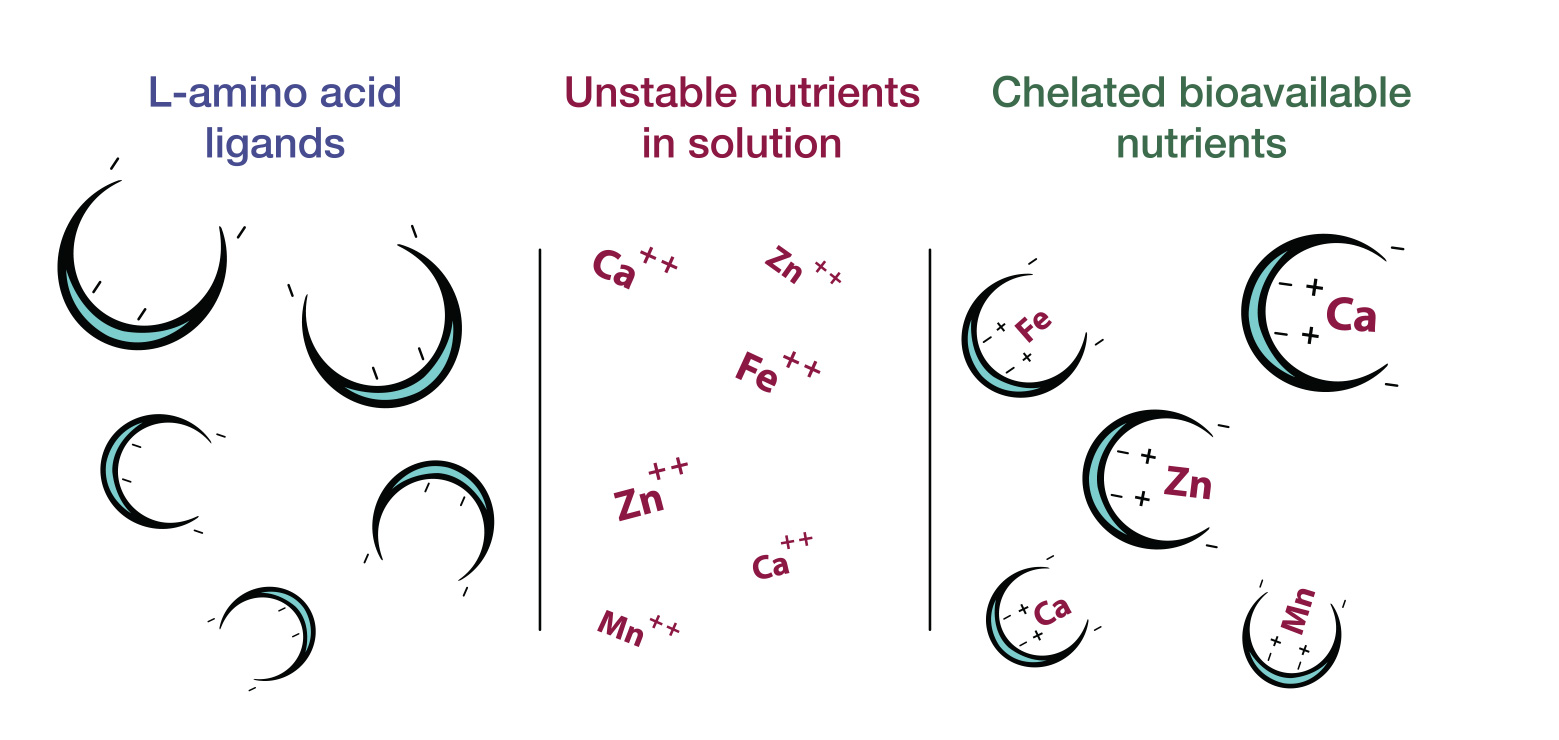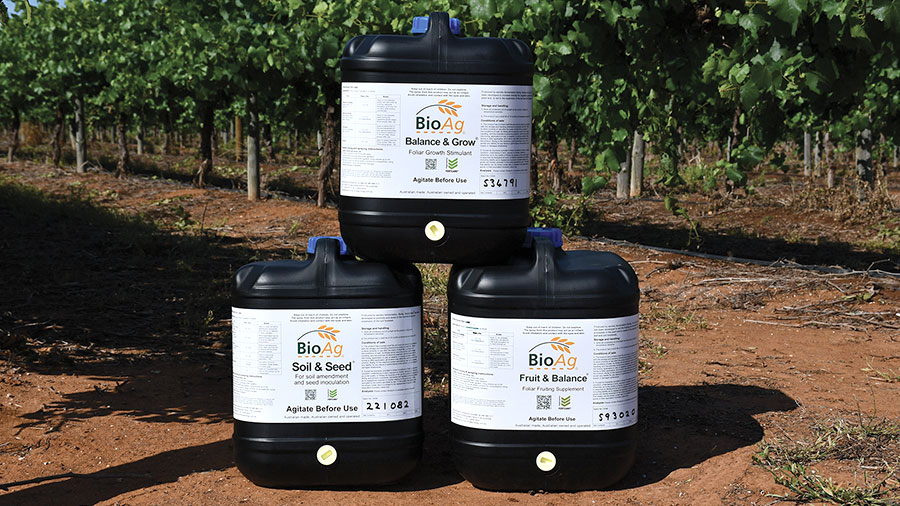
Latest
News
BioAg proprietary products escorting nutrients for better crop performance
Micronutrients play a critical role in fruit set and fruit development. In viticulture or horticulture – now is the time to consider your needs for micronutrients and how to best deliver them to your crop.

Chelation is an efficient way of enhancing nutrient availability
Micronutrients such as Fe, Mn, Zn, and Cu are easily oxidized or precipitated in soil, and their utilisation is, therefore, not efficient. Chelated fertilisers have been developed to increase micronutrient utilisation efficiency. The word chelate is derived from the Greek word chelé, which refers to a lobster’s claw. Hence, chelate refers to the pincer-like way in which a metal nutrient ion is encircled by the larger organic molecule ‘the claw’, usually called a ligand or chelator.
Chelated micronutrients are protected from oxidation, precipitation, and immobilisation in certain conditions because the organic molecule (the ligand) can combine and form a ring encircling the micronutrient. The pincer-like way the micronutrient is bonded to the ligand changes the micronutrient’s surface properties and improves the uptake efficiency of foliar applied micronutrients [iii].
The three main classes of micronutrient sources are inorganic, synthetic chelates and organic complexes. Inorganic sources such as sulphates of Cu, Mn, Fe and Zn are the most common metallic salts used in the fertiliser industry because of their immediate plant availability and water solubility.
Metals bound in chelate rings have essentially lost their cationic (metallic salt) characteristics. The stability of a micronutrient chelate generally determines plant availability of the applied micronutrient. The chelated forms of micronutrients have several advantages over more traditional forms of trace elements such as oxides and sulphates [iv]:
- Chelates are not readily leached from the soil as they adsorb on to the surface of soil particles.
- Chelates do not readily bind with soil antogonists, whereas soil antogonists will readily bind with metallic salts.
- Lower quantities are needed compared to inorganic compounds because they are completely assimilable by crops.
- Chelates are easily absorbed by plant roots or leaves because chelates are of organic nature. The chelation process removes the positive charge from the micronutrients allowing the neutral or slightly negatively charged chelates to slide through the pores on the leaf and root surface more rapidly. Since these pores are negatively charged, positively charged micronutrients would normally be ‘fixed’ at the pore entrance.
- Chelates are more easily translocated within the plant.
- Under alkaline conditions, chelated Fe, Zn, Mn and Cu is a better way to provide micronutrients to a crop.
- Chelates are compatible with a wide variety of pesticides and liquid fertilisers, as chelates do not react with their components. Most chelates can be mixed with dry mixes and liquid fertilisers.

Amino acids increase plant bioavailability of nutrients
Amino acid chelates is an emerging technology for delivering selected micronutrients with maximum bioavailability and safety. The advantages of using this technology are that the amino acid ligands surround and protect the micronutrients from adverse interactions. Which typically take place in the soil solution, in the presence of soil or on leaf surfaces. Natural amino acids are used to chelate the micronutrients and hence they are rapidly absorbed, translocated and metabolised by plants.
Chelated minerals are well suited for direct foliar application, as the leaves of most plants along with cell walls serve as a barrier to the absorption of free metal ions. Whereas chelated micronutrients freely pass through these barriers. When the amino acid chelates reach the cell membrane, they are recognised by the mechanisms of absorption as a source of organic nitrogen (N) [iv]. For example, L – glycine and L – glutamic acid are known to be very effective chelating agents [v].
Fertigation is becoming one of the most popular methods of application for chelated micronutrients. They are very efficient in high pH soils and when high pH water is used to grow crops [vi].
BioAg Soil & Seed delivers better yields through greater fertiliser efficiency and soil property improvement
While nutrient deficiencies are often addressed, deficiencies of biological or organic molecules, compounds and catalysts that exist in the plant are often ignored or are harder to detect.
BioAg is a manufacturer of microbiological biostimulants through a unique fermentation technology. It is a revolutionary combination of essential nutrients and metabolites, a complexed food source for microbiome and plant that includes carbohydrates, humic compounds, vitamins, macro-and microminerals, as well as a range of free L-amino acids. The amino acids present in BioAg’s biostimulants (His, Ser, Arg, Gly, Asp, Glu, Thr, Ala, Pro, Lys, Tyr, Met, Val, Iso, Leu, Phe, Try) are derived from microbial activity, so they are all the L-isomer – the available form for both plants and soil micro-biology [vii]. It is only L-amino acids that can be utilised in the building of proteins and in plant metabolic processes.
Except being very effective chelating agents, amino acids are also important as they act as precursors to many metabolic functions (precursors of plant hormones growth stimulators, anti-stress agents, protein and chlorophyll synthesis, etc.) within the plant. The application of “ready for uptake” amino acids allows plants to save energy and increase their pace of development or reconstruction, especially beneficial in critical times of plant development or when plants are stressed.
BioAg Soil & Seed acts as an excellent soil inoculant, feeds and expands the volume and diversity of beneficial soil micro-organisms, including bacteria, fungi, yeast and protozoa. It improves nutrients’ plant availability, supplying soil with beneficial microorganisms that dynamically mineralise and solubilise nutrients, and create organic complexes for efficient nutrient absorption. Furthermore, Soil & Seed improves soil properties to mitigate heavy clay or/and high Mg soil characteristics and related waterlogging and nutrient uptake issues.
BioAg Balance & Grow is designed to deliver foliar macro-and micronutrients, and also an additional broad range of biological compounds and food sources. This broad-spectrum approach means the plant has access to a greater amount and variety of foods during the critical vegetative growth phase, while its internal functions are better able to deal with nutrient imbalances and environmental stresses. Application of Balance & Grow stimulates vegetative growth, enlarges photosynthetic surface and increases photosynthesis rates in the plant. The result is very balanced delivery of a wide range of benefits to growing plants.
BioAg Fruit & Balance contains fruiting nutrients in a highly evolved and plant available state, designed for maximum foliar uptake. It pushes the plant into a strong fruiting state, maximising fruit or seed set and assisting the plant to carry this load for maximum yield and quality (enhances the nutritional value and quality of fruit or grain by increasing nutrient content and sugar levels).
BioAg’s liquid fermented culture range are natural bio-chelators. Together, Soil & Seed, Balance & Grow and Fruit & Balance provide plants with bioactive components and accompany nutrients. They will improve the efficiency of all fertiliser regimes to boost efficiency and sustainability. Talk to your BioAg agronomist to discuss other nutrient and pesticides tank mixes. BioAg’s biostimulants are also available in an organic variant.
More information on amino acids and the critical roles they play in plant growth can be found by referring to the BioAg white paper on amino acids below.
References
[i] Aye K. S. (2011). Investigation on the effectiveness of zinc sulphate and biofertilizer on mustard plant. World Acad. Sci. Eng. Technol. 75 335–337.
[ii] Singh, U. (2020) Micronutrients’ roles in improving crop yields and the effectiveness of nanoscale formulations. The International Fertilizer Development Center (IFDC).
[iii] Liu, G., Hanlon, E., Li, Y. (Revised 2018) Understanding and Applying Chelated Fertilizers Effectively Based on Soil pH. Horticultural Sciences Department, UF/IFAS. https://edis.ifas.ufl.edu.
[iv] Sekhon, Bhupinder. (2003). Chelates for micronutrient nutrition among crops. Resonance. 8. 46-53. 10.1007/BF02834402.
[v] Johansson A. (2008) Conversations on chelation and mineral nutrition. Aust. J. Grape Wine Res. 583:53–56.
[vi] Nawrocki A. (2020) Plant micronutrient uptake challenges and the benefits of chelated fertilizers. IFA. www.fertilizer.org
[vii] Australian Proteome Analysis Facility (APAF)

Recent Comments